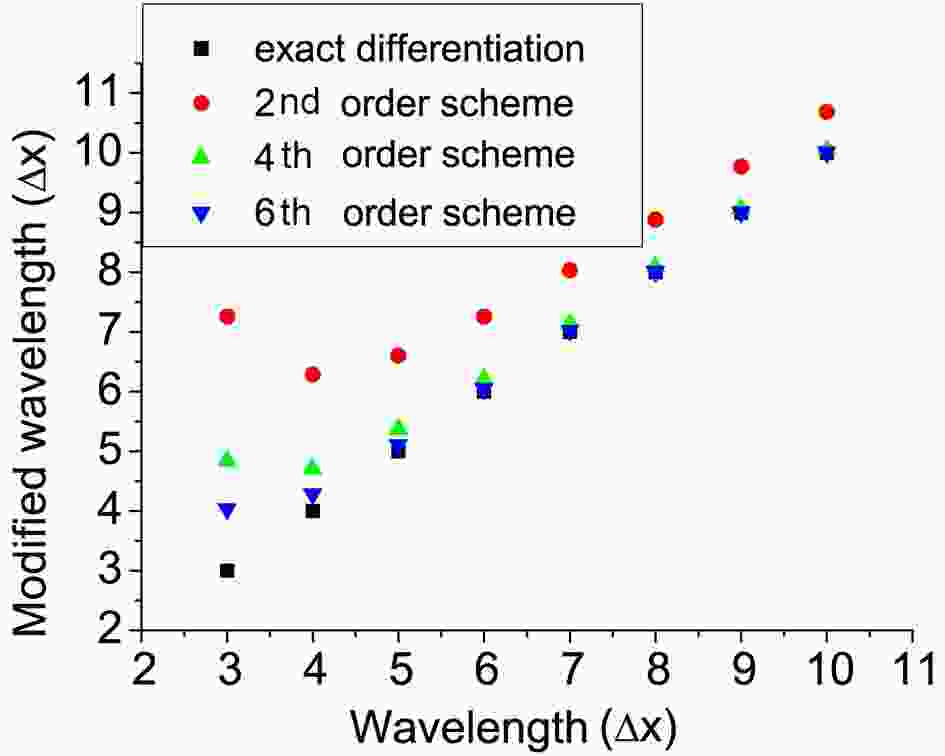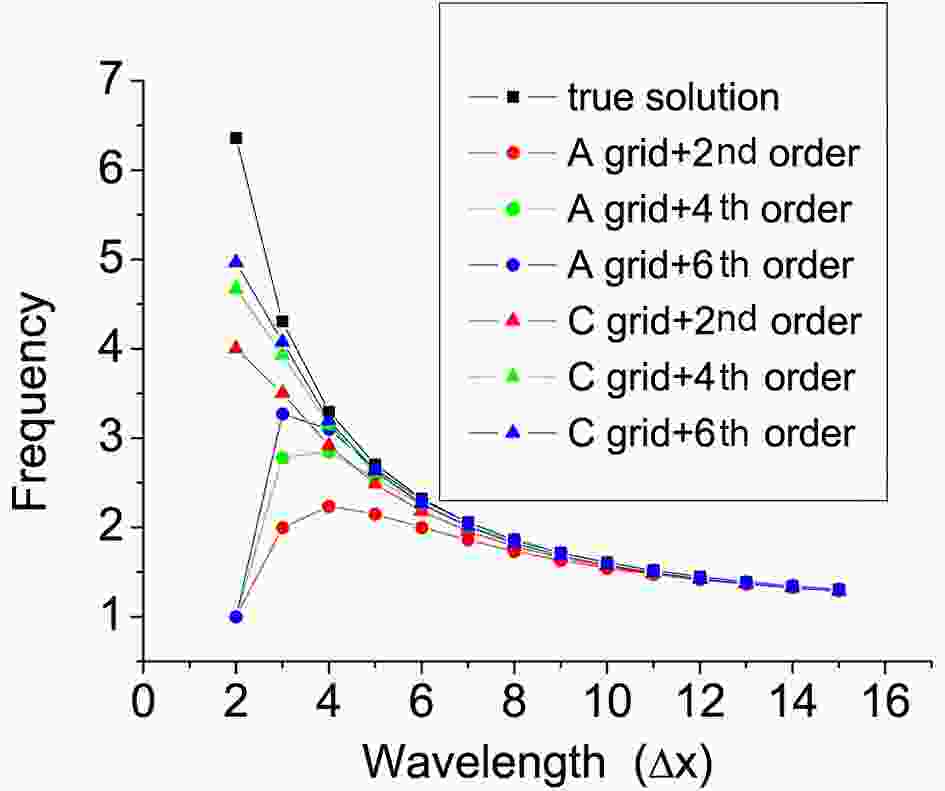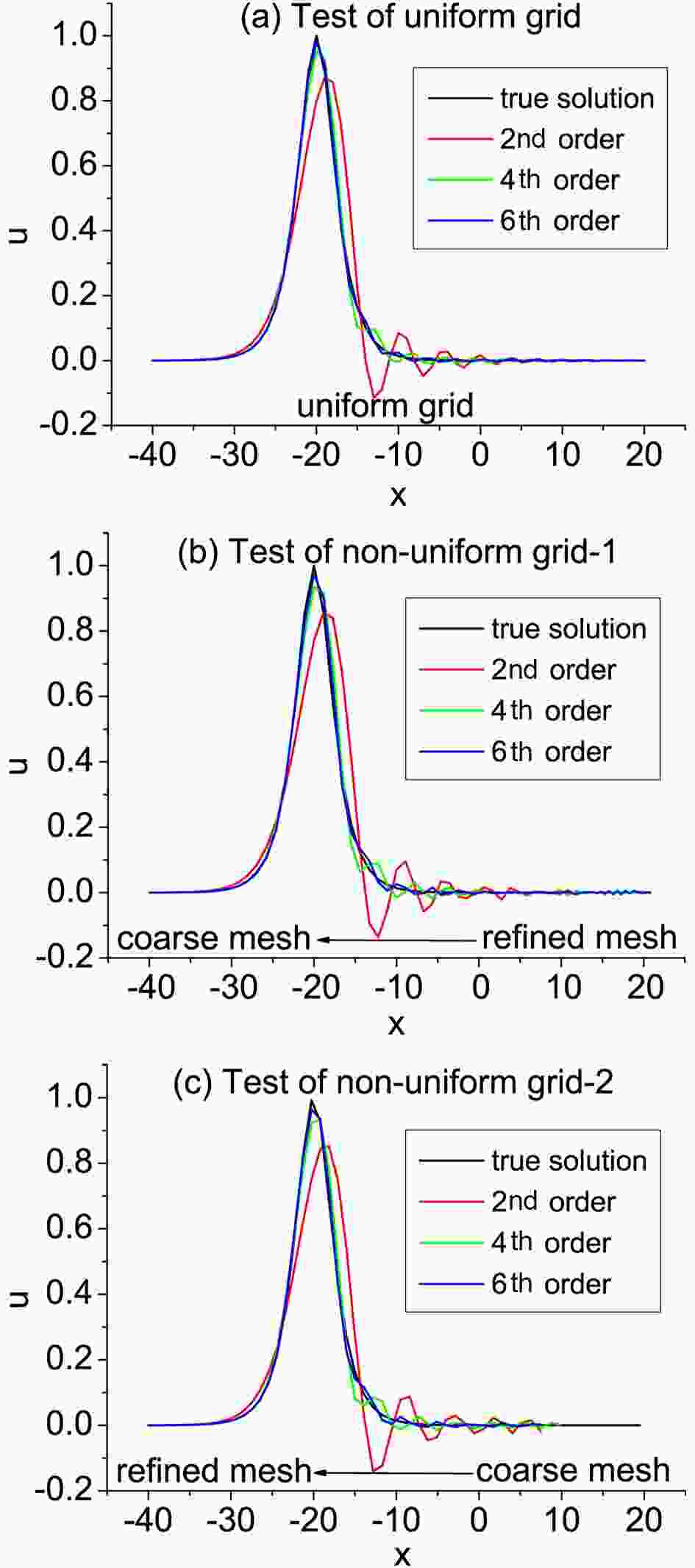HTML
--> --> -->High-order difference schemes have been widely applied in ocean models. McCalpin (1994) compared 2nd-order and 4th-order pressure gradient algorithms in a sigma coordinate ocean model and found that the higher-order scheme was helpful to improve the accuracy and stability of the model. Chu and Fan (1997, 2000) further implemented a 6th-order difference scheme in a sigma ocean model to reduce the truncation error in calculating the horizontal pressure gradient term. A control-volume ocean model with a 4th- and 5th-order finite difference scheme was presented by Sanderson and Brassington (2002).
The accuracy of discretization for dynamic equations in numerical weather prediction (NWP) is an important issue for its performance, so how to design accurate high-order schemes for NWP models has long been a research focus (Cullen and Davies, 1991; Lin and Rood, 1996; Yang et al., 2015). Sch?r et al. (2002) demonstrated the beneficial impact on reducing small-scale noise by higher-order difference schemes with an idealized advection test. Feng and Li (2007) developed a high-order upwind-biased difference scheme, and tested its computational performance with the one-dimensional advection equation and inviscid Burgers’ equation. A high-order positive-definite conservative multi-moment center constrained finite volume transport model was presented by Shu et al. (2020) to improve the moist transport in NWP models.
In recent years, construction of dynamic cores with high accuracy has become one of the main international trends in developing new-generation NWP models. The truncation error of the GFDL finite volume cubed-sphere dynamical core (FV3, Lin, 2004 2008) reached 3rd order. Li et al. (2015) built a 3rd- and 4th-order multi-moment constrained finite-volume method and tested it with a global shallow-water model on the Yin–Yang grid. At present, a central difference scheme with 2nd-order accuracy is still applied for the horizontal discretization of the Global-Regional Assimilation and Prediction System (GRAPES) model, which severely limits its computational performance. It will be meaningful to introduce a higher-order difference scheme for the horizontal discretization in the GRAPES model.
Considering the difficulty of coupling the compact difference scheme with a semi-implicit and semi-Lagrange time discretization scheme in the GRAPES model, we adopted the traditional finite difference scheme to construct a higher-order dynamic core. As the application of high-order difference schemes in operational NWP models is still very rare, their properties need to be further investigated before being implemented in the GRAPES model, which is the main purpose of this paper. The equations of high-order schemes based on Taylor series is displayed in section 2. Dispersion properties of high-order schemes are presented in section 3, and the performance under non-uniform and non-orthogonal grid conditions is presented in sections 4 and 5. Section 6 discusses the impact of high-order finite difference schemes on computational efficiency when implemented in the GRAPES model. Finally, a summary and discussion are provided in section 7.
| Unstaggered grids | Staggered grids | |
| 2nd order | $ \dfrac{{f}_{i+1}-{f}_{i-1}}{2\Delta x} $ | $ \dfrac{{f}_{i+0.5}-{f}_{i-0.5}}{\Delta x} $ |
| 4th order | $ \dfrac{{f}_{i-2}-8{f}_{i-1}+8{f}_{i+1}-{f}_{i+2}}{12\Delta x} $ | $ \dfrac{{f}_{i-1.5}-27{f}_{i-0.5}+27{f}_{i+0.5}-{f}_{i+1.5}}{24\Delta x} $ |
| 6th order | $ \dfrac{-{f}_{i-3}+9{f}_{i-2}-45{f}_{i-1}+45{f}_{i+1}-9{f}_{i+2}+{f}_{i+3}}{60\Delta x} $ | $ \dfrac{-9{f}_{i-2.5}+125{f}_{i-1.5}-2250{f}_{i-0.5}+2250{f}_{i+0.5}-125{f}_{i+1.5}+9{f}_{i+2.5}}{1920\Delta x} $ |
| Notes: $ f $ represents an arbitrary function, and $ \Delta x $ represents grid length in discretization. | ||
Table1. Difference schemes with 2nd-, 4th- and 6th-order accuracy for the first derivative under unstaggered and staggered grids.
The Fourier analysis of error for difference schemes for first- and second-derivative approximation under an unstaggered grid is shown in Fig. 1 (for the detailed process of derivation, see Appendix B). The improvement of the higher-order schemes in resolving short waves is significant, especially from 2nd- to 4th-order accuracy.
 Figure1. Fourier analysis of error for the first derivative approximation with different schemes under an unstaggered grid.
Figure1. Fourier analysis of error for the first derivative approximation with different schemes under an unstaggered grid.where u and v are the horizontal components of wind in the x and y directions, h is the depth of fluid,




where L is the wavelength in the x direction.
The effect of space discretization error can now be examined. The following frequencies are obtained for Arakawa-A and Arakawa-C grids (the radius of deformation



A grid + 2nd order:
A grid + 4th order:
A grid + 6th order:
C grid + 2nd order:
C grid + 4th order:
C grid + 6th order:
As shown by Fig. 2, the frequencies get closer to the true solution when higher-order difference schemes are applied, both in the A grid and C grid for


 Figure2. The dependency of (nondimensional) frequency
Figure2. The dependency of (nondimensional) frequency 

The performance of higher-order schemes under a non-uniform grid is investigated with the following one-dimensional advection equation based on an unstaggered grid:
Here,


2
4.1. Test with a smooth wave solution
When the initial value is set as






Uniform grid:
Nonuniform grid ? 1:
Nonuniform ? grid ? 2:
The grid spacing is gradually reduced in Non-uniform-grid-1 from left to right, while the opposite is the case in Non-uniform-grid-2. As shown in Fig. 3, the dissipation and phase errors of the nonuniform and uniform grid are very close to each other, which implies that the dissipation and dispersion properties of higher-order difference schemes will not be degenerated by the weak uniformity of grids. The improvement from the 2nd-order scheme to the 4th-order scheme is most obvious, while the difference between the 4th-order scheme and the 6th-order scheme is very small. This is consistent with the result of Fourier analysis in section 2. The results of the tests for nonuniform-grid-1 and nonuniform-grid-2 are very similar to each other, which also supports the conclusion that weak non-uniformity will not influence the performance of high-order difference schemes.
 Figure3. Numerical test of the one-dimensional advection equation at t = 10 s in (a) a uniform grid, (b) non-uniform grid-1, and (c) non-uniform grid-2.
Figure3. Numerical test of the one-dimensional advection equation at t = 10 s in (a) a uniform grid, (b) non-uniform grid-1, and (c) non-uniform grid-2.In general, the higher-order difference scheme are still effective for the non-uniform grid if the variation of grid distance is smooth, so they are applicable for the longitude–latitude grid of the GRAPES model and the non-uniform vertical difference process.
2
4.2. Test with a square wave solution
To study the performance of high-order difference schemes under more discontinuous conditions, a square wave test was further performed. In the square wave test, the initial value of the one-dimensional advection equation [Eq. (11)] was set asThe parameters were set the same as in section 4.1, and the advection test was performed under a uniform grid. Figure 4 shows the simulated square signals at t = 1 s. The overshoot and undershoot noise were alleviated by the higher-order (4th- and 6th-order) schemes. This implies that the advantages of high-order schemes can be extended to the non-modal solutions, although the theoretical analysis is difficult.
 Figure4. The result of the square test at t = 1 s.
Figure4. The result of the square test at t = 1 s.The two-dimensional advection equation under a terrain-following vertical coordinate can be written as (Li et al., 2012)
where























where
and where






 Figure5. Schematic diagram of the non-orthogonal grid mesh for the two-dimensional advection test (black shaded area denotes the topographic obstacle).
Figure5. Schematic diagram of the non-orthogonal grid mesh for the two-dimensional advection test (black shaded area denotes the topographic obstacle).In the idealized advection test, the topographic obstacle is submerged within a stagnant air mass, but aloft there is a uniform and purely horizontal flow directed from left to right (shown in Fig. 6). The anomaly is assigned the shape
 Figure6. Vertical cross section for the idealized two-dimension advection test: (a) vertical distribution of velocity u; (b) analytical solution of the density as advected for three instances.
Figure6. Vertical cross section for the idealized two-dimension advection test: (a) vertical distribution of velocity u; (b) analytical solution of the density as advected for three instances.with








where





The error fields for the 2nd-, 4th-, and 6th-order difference schemes are displayed in Fig. 7. As the anomaly is located over the obstacle (at t = 5000 s), the reduction of spurious small-scale distortion errors caused by higher-order schemes is obvious at the right-upper side of the obstacle (see Figs. 7a, c and e), although the orthogonality of the grid is partly influenced by the terrain. The improvement is much more apparent when the computational accuracy is increased from 2nd to 4th order. When the non-orthogonality gets much more severe, the forecast error (see the error above the terrain at t = 10000 s in Figs. 7b, d and f) is almost the same for different schemes.
 Figure7. Numerical error of difference schemes for the two-dimensional advection equation: (a, b) 2nd-order scheme; (c, d) 4th-order scheme; (e, f) 6th-order scheme; (a, c, e) t = 5000 s; (b, d, f) t = 10000 s.
Figure7. Numerical error of difference schemes for the two-dimensional advection equation: (a, b) 2nd-order scheme; (c, d) 4th-order scheme; (e, f) 6th-order scheme; (a, c, e) t = 5000 s; (b, d, f) t = 10000 s.In general, the performance of high-order difference schemes highly depends upon the orthogonality of the model grid, and the advantage of high-order difference schemes can still be retained when the grid is nearly orthogonal.
The dynamic equation of the GRAPES model under a spherical coordinate system can be written as (Chen and Shen, 2006)
where
















where


The generalized conjugate residual (GCR) method is used to solve the Helmholtz equation in the GRAPES model. To accelerate the speed of convergence, a preconditioned algorithm is applied to simplify the coefficient matrix. According to the fact that the coefficients at points (












| Coefficient | Magnitude | Coefficient | Magnitude |
| B1 | 100 | B16–B19 | 10?4 |
| B2–B4 | 10?2 | B20–B23 | 10?3 |
| B5–B9 | 10?8 | B24–B35 | 10?8 |
| B10, B15 | 10?1 | B36–B43 | 10?5 |
| B11–B14 | 10?5 | B44–B47 | 10?5 |
Table2. Magnitude of coefficients in Eq. (27).
In general, a high-order finite difference scheme is a feasible choice for a high-resolution, longitude–latitude grid model with a nearly uniform and orthogonal regional domain—for example, the Tropical Regional Area Model System (TRAMS; Xu et al., 2015) developed by the Guangzhou Institute of Tropical and Marine Meteorology, based on the regional version of GRAPES.
Although the result of the two-dimensional advection test under a terrain-following coordinate is in a similar spirit to the analysis of Reinecke and Durran (2009), it can still be misleading since reflections in the one-way advection equation are nearly always into grid-scale wavelengths that are easily diffused for a relatively long-term simulation (Harris and Durran, 2010). Extending a similar test to a more dynamically active case supporting upstream physical wave propagation (Vichnevetsky, 1987) will be more meaningful. A complete study of the performance by implementing high-order schemes in TRAMS will be the next stage in our work. A general finite high-order difference scheme applicable in a non-uniform grid will also be investigated in the future.
Acknowledgements. This work was supported by the National Natural Science Foundation of China (Grant No. U1811464) . We thank the two anonymous reviewers and the editors for their comments, which greatly improved this paper.
APPENDIX ADerivation of High-Order Difference Schemes based on the Taylor Series Expansion Method
The general finite difference equations with arbitrary order accuracy are deduced first, followed by the specific forms of the 2nd-, 4th- and 6th-order schemes.
1.????Equations of traditional finite difference schemes with?????? arbitrary order accuracy
The method to deduce high-order difference schemes at one point can be summarized as follows: the number of grid points needed for the required accuracy is determined first; then the expression of derivatives including indefinite coefficients are deduced; and finally these indefinite coefficients will be obtained by solving the set of simultaneous equations based on Taylor series expansion.
The following 2n + 1 grid will be used to contract 2n-order accuracy schemes for the first derivative:
The expansion of derivations can be written as (with coefficients undetermined):
The function









2.????Second-order difference scheme
Let

Substituting Eq. (A3) and Eq. (A6) into Eq. (A9), and omitting the remainder terms, we can obtain:
The following coefficients can be derived by equaling the corresponding terms in Eq. (A10):
The 2nd-order finite difference scheme for the first derivative can now be expressed as:
3.????Fourth-order difference scheme
Let n = 2 in Eqs. (A1)–(A2), and the expression of the 4th-order scheme can be obtained. The expansion of Eq. (A1) is
Substituting Eqs. (A3)–(A4) and Eqs. (A6)–(A7) into Eq. (A13),
where
The 4th-order finite difference scheme for the first derivative can now be expressed as:
4.????Sixth-order difference scheme
Let n = 3 in Eqs. (A1)–(A2), and the expression of the 6th-order scheme can be obtained. The expansion of Eq. (A1) is
Substituting Eqs. (A3)–(A5) and Eqs. (A6)–(A8) into Eq. (A17), and omitting the remainder terms, we can obtain:
where
The 6th-order finite difference scheme for the first derivative can now be expressed as:
For the staggered grid, the following 2nd-, 4th- and 6th-order finite difference schemes can be obtained with a similar method:






According to the properties of Fourier transition, we can get
where

and its Fourier analysis error can be obtained by performing the Fourier transform on both sides of Eq. (B5):
Hence,
With the wavelength defined as

where

The following Fourier analysis error of the 4th- and 6th-order approximations can be derived with a similar method:
4th-order scheme:
6th-order scheme:
